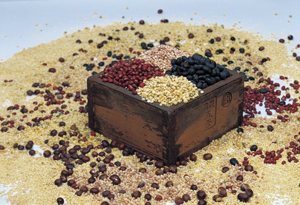Featured Food: Whole Grains

When we think of nature's superfoods, at the top of the list is surely whole grains—they've sustained cultures around the globe for millennia.
With developments in modern technology came our ability to refine, process and generally de-nature our foods. I'm all for technological advancement, but there's a lot to be said for simple, natural living. As with the never-ending cycles of life, the trends must eventually take us back around to a desire to embrace some of our "traditions" and take from them that which can serve our advancement toward a healthier and more sustainable future.
To many people, eating whole grains simply implies opting for whole wheat bread instead of white bread or eating whole wheat pasta. Of course, this is a step in the right direction, but when you break down a grain to make flour for baking bread or making pasta, some of its integrity and nutritional value is diminished. The optimum way to consume grains is in their whole, unrefined state, with bran and germ intact. In this way, we're getting all the benefits of the grain—the essential fiber, B vitamins and trace minerals in the bran and protein and the vital essential oils, vitamin E, vitamin B and phytonutrients in the germ.
Integrating whole grains into your diet is an affordable and, with a little creativity, delicious way to ensure good health and optimum nutrition. The world of whole grains is too vast to cover in one post, so I've chosen four staples to begin with: rice, quinoa, millet and barley.
The secrets to cooking with rice
With developments in modern technology came our ability to refine, process and generally de-nature our foods. I'm all for technological advancement, but there's a lot to be said for simple, natural living. As with the never-ending cycles of life, the trends must eventually take us back around to a desire to embrace some of our "traditions" and take from them that which can serve our advancement toward a healthier and more sustainable future.
To many people, eating whole grains simply implies opting for whole wheat bread instead of white bread or eating whole wheat pasta. Of course, this is a step in the right direction, but when you break down a grain to make flour for baking bread or making pasta, some of its integrity and nutritional value is diminished. The optimum way to consume grains is in their whole, unrefined state, with bran and germ intact. In this way, we're getting all the benefits of the grain—the essential fiber, B vitamins and trace minerals in the bran and protein and the vital essential oils, vitamin E, vitamin B and phytonutrients in the germ.
Integrating whole grains into your diet is an affordable and, with a little creativity, delicious way to ensure good health and optimum nutrition. The world of whole grains is too vast to cover in one post, so I've chosen four staples to begin with: rice, quinoa, millet and barley.
The secrets to cooking with rice



